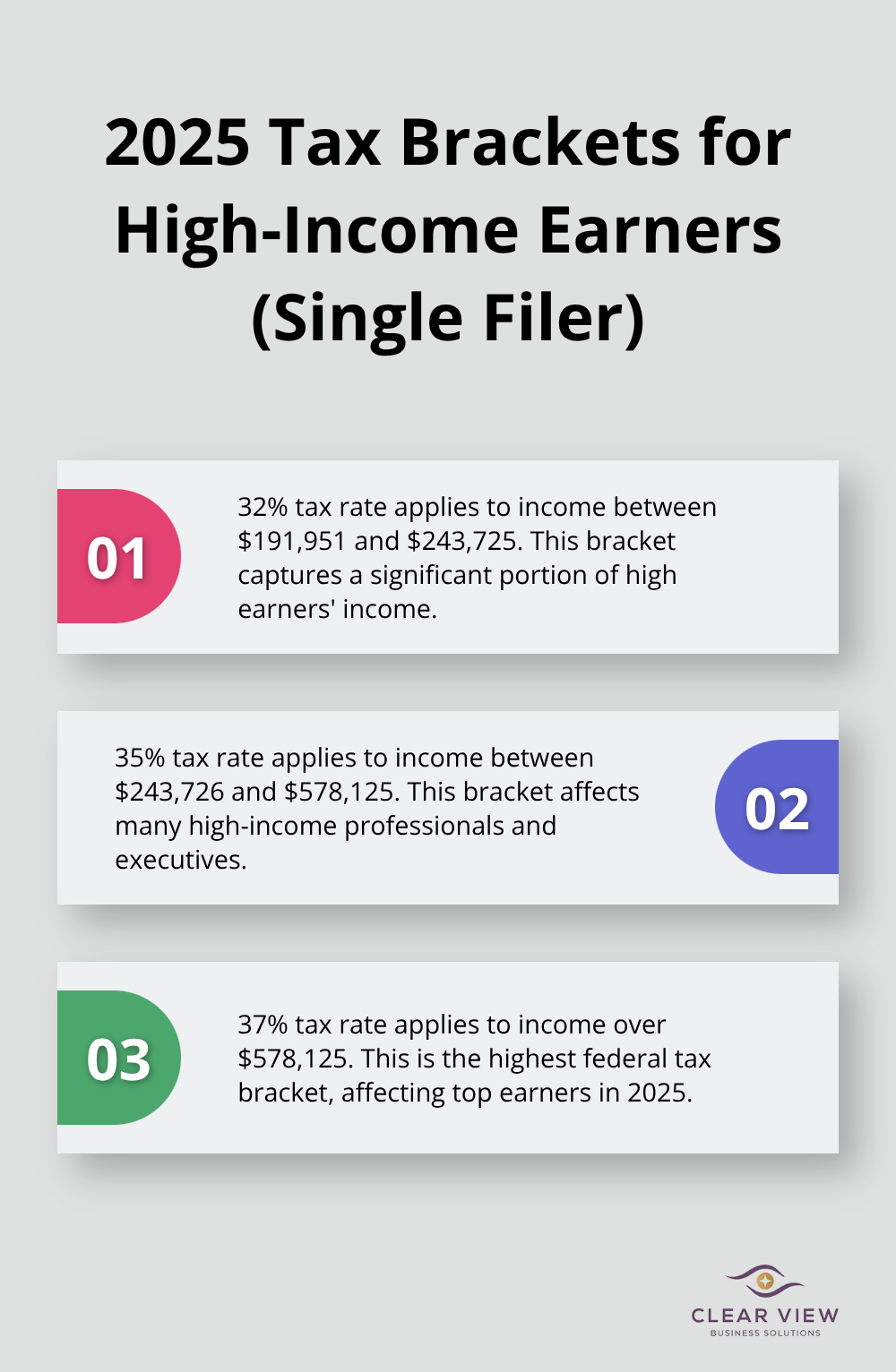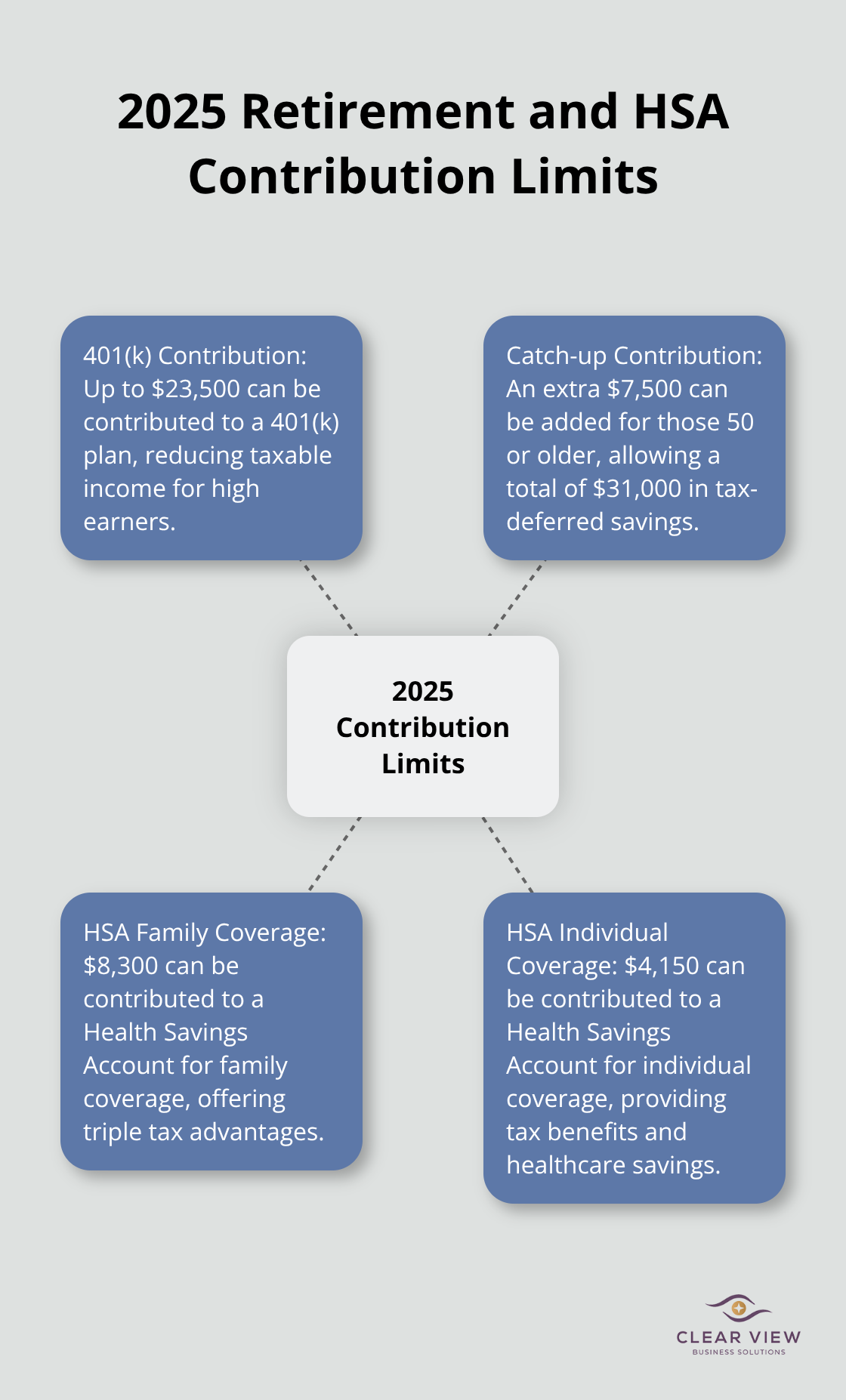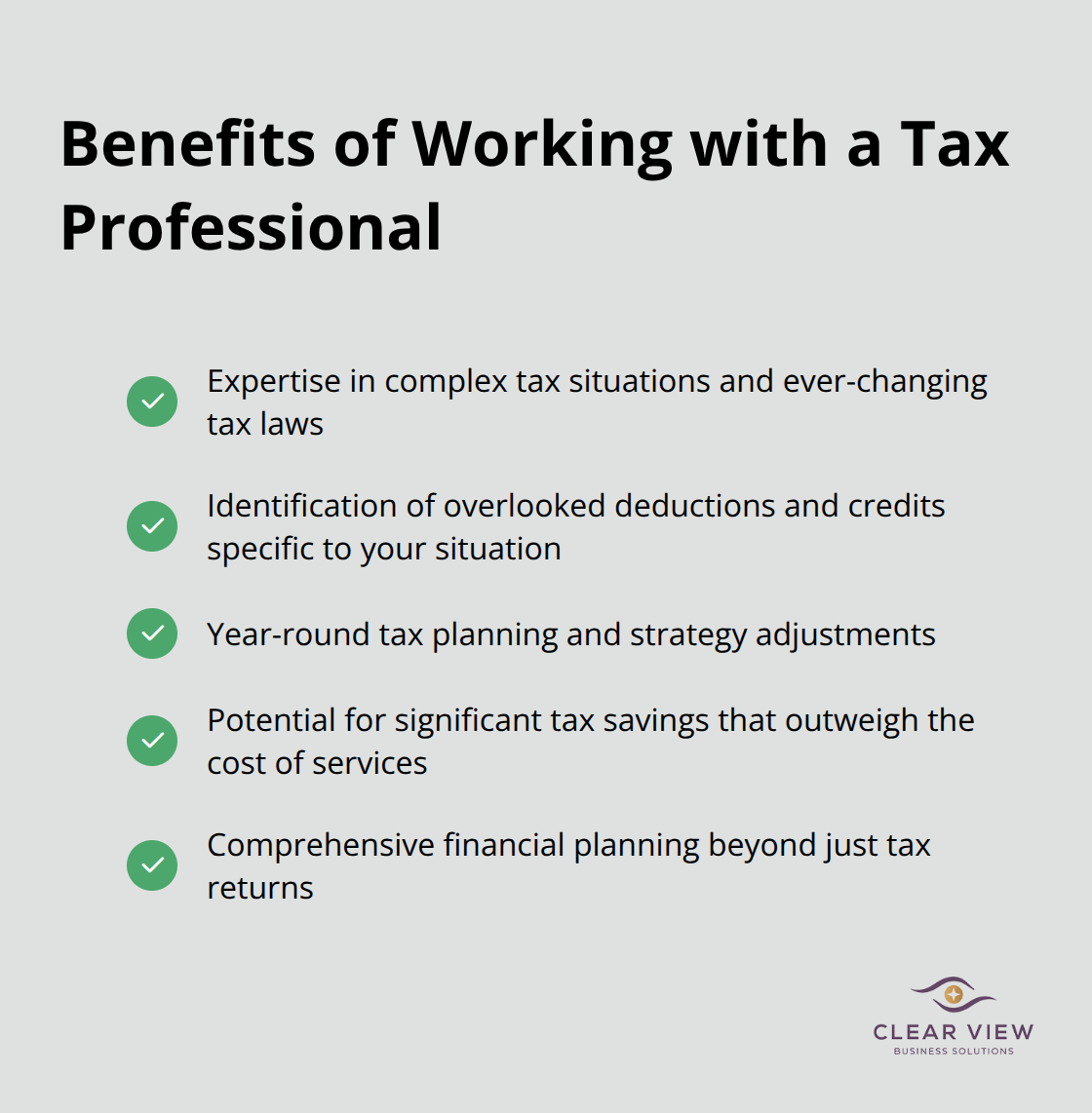

Tax planning strategies for high income earners can significantly impact your financial future. As your income grows, so does the complexity of your tax situation.
At Clear View Business Solutions, we understand the unique challenges faced by high earners when it comes to managing their tax obligations.
This guide will explore effective strategies to optimize your tax position, from understanding tax brackets to leveraging smart investment choices and working with professionals.
The U.S. tax system operates on a progressive scale. As you earn more, you move into a higher tax bracket, which means the IRS taxes a higher percentage of your income above a specific threshold at a higher rate. In 2025, the highest federal tax bracket will be 37% for individuals earning over $578,125 and married couples filing jointly earning over $693,750. However, this doesn’t mean all your income is taxed at 37%. Only the portion of your income that falls into this bracket is taxed at the highest rate.
For example, if you’re a single filer earning $600,000 in 2025, you’ll pay:

Your marginal tax rate is the highest tax bracket you fall into, but your effective tax rate is the average rate you pay on your total taxable income. For high earners, understanding this difference is key to strategic tax planning.
As your income increases, you may lose certain deductions and credits. For instance, the ability to contribute directly to a Roth IRA phases out for high earners. In 2025, the phase-out range for single filers is expected to be between $146,000 and $161,000.
Additionally, high income earners may face the Net Investment Income Tax (NIIT) of 3.8% on certain investment income if their modified adjusted gross income exceeds $200,000 for single filers or $250,000 for married couples filing jointly.
Navigating the complexities of tax brackets and their implications requires expert knowledge. Professional tax advisors can provide personalized strategies to optimize your tax position while ensuring compliance with current tax laws. They can help you identify opportunities to reduce your taxable income, maximize deductions, and make informed decisions about your investments and financial planning.
As we move forward, we’ll explore specific tax planning strategies that can help high income earners minimize their tax burden and maximize their wealth accumulation potential.
High income earners must maximize their retirement accounts. In 2025, you can contribute up to $23,500 to your 401(k), with an extra $7,500 catch-up contribution for those 50 or older. This allows you to shield $31,000 from taxes in a single year. If your employer offers a Mega Backdoor Roth option, you might be able to contribute even more to your 401(k) in 2025, depending on your age and eligibility for catch-up contributions.
Don’t overlook Health Savings Accounts (HSAs) after maxing out your 401(k). In 2025, you can contribute $4,150 for individual coverage or $8,300 for family coverage. HSAs offer a triple tax advantage: tax-deductible contributions, tax-free growth, and tax-free withdrawals for qualified medical expenses.

Tax-efficient investing can significantly impact your bottom line. Municipal bonds often attract high earners because the interest is typically exempt from federal taxes (and sometimes state and local taxes). For example, a 5% yield on a muni bond could equal a 7.94% taxable yield for someone in the 37% tax bracket.
Try to hold your most tax-inefficient investments (like REITs or high-yield bonds) in tax-advantaged accounts, while keeping more tax-efficient investments (like index funds) in taxable accounts. This approach, known as asset location, can boost your after-tax returns without altering your overall investment strategy, especially for clients subject to high income tax rates.
Charitable giving benefits both society and your tax bill. Consider setting up a Donor-Advised Fund (DAF). You can contribute a lump sum in a high-income year, receive the full tax deduction immediately, and then distribute the funds to charities over time. This strategy works particularly well if you’re near the edge of a tax bracket.
For those over 70½, Qualified Charitable Distributions (QCDs) allow you to donate up to $100,000 directly from your IRA to charity. This counts towards your Required Minimum Distribution but doesn’t increase your taxable income.
Timing plays a crucial role in tax planning. If you control when you receive income or pay deductible expenses, you can strategically bunch them into alternating years. This approach helps you itemize deductions one year and take the standard deduction the next, maximizing your tax savings over time.
Business owners or those with variable income should consider accelerating expenses into the current year if they expect to be in a higher tax bracket. Conversely, if you anticipate being in a lower bracket next year, try to defer income if possible.
Tax laws change frequently, and what works this year might not be optimal next year. Working with a professional who can tailor these strategies to your unique situation and keep you updated on the latest tax law changes is essential. Clear View Business Solutions offers comprehensive tax planning services that can help you navigate these complex decisions and optimize your tax position.
High-income earners face complex tax situations that demand specialized knowledge. While DIY tax software might suffice for simpler returns, it often falls short for those with intricate financial portfolios. A certified tax advisor brings expertise that can save you thousands in taxes and penalties.
Tax professionals stay up-to-date with ever-changing tax laws and regulations. The Tax Cuts and Jobs Act of 2017, for example, extended the Child Tax Credit to higher-income families by substantially increasing the income thresholds at which the credit phases out. A skilled advisor can help you take advantage of these changes. They identify deductions and credits you might overlook (such as the home office deduction for self-employed individuals or the research and development credit for business owners).

When choosing a tax professional, look for credentials like Certified Public Accountant (CPA) or Enrolled Agent (EA). These designations indicate a high level of expertise and adherence to ethical standards. However, credentials alone don’t guarantee the best fit.
Seek someone with experience in high-income tax strategies and familiarity with your specific financial situation. Ask potential advisors about their experience with clients in similar income brackets or industries. A tax pro who regularly works with executives or business owners in your field will likely have insights into industry-specific deductions and strategies.
Effective tax planning is not a once-a-year activity; it requires year-round attention. A good tax advisor will meet with you regularly to review your financial situation and adjust strategies as needed. They should proactively suggest ways to minimize your tax liability.
For instance, if you consider selling a highly appreciated asset, your advisor might suggest spreading the sale over multiple tax years to avoid pushing you into a higher tax bracket. They might also recommend pairing the sale with charitable giving strategies to offset the tax impact.
The cost of professional tax services often pales in comparison to the potential tax savings they provide. As your income grows, so does the complexity of your tax situation. Partnering with a skilled tax professional isn’t just a luxury-it’s a smart financial move that can significantly impact your long-term wealth accumulation.
A tax professional doesn’t just look at your tax return; they examine your entire financial picture to create a comprehensive strategy. This might include advice on retirement contributions, investment choices, and business structuring to maximize tax efficiency.
Tax planning strategies for high income earners require a proactive approach. High earners must understand tax brackets, maximize retirement accounts, and explore tax-efficient investments to reduce their tax burden. Charitable giving and strategic timing of income and deductions can lead to substantial tax advantages.
Tax regulations change frequently, which emphasizes the need for expert guidance. A qualified tax professional can provide personalized strategies tailored to your unique financial situation. They will help you take advantage of every available opportunity to optimize your tax position.
Clear View Business Solutions specializes in comprehensive tax planning for high income earners. Our team of experts stays current with the latest tax laws, providing personalized advice to help you navigate complex financial decisions. We offer tax planning, accounting, and bookkeeping services designed to help you achieve financial stability and growth.
At Clear View Business Solutions, we know you want your business to prosper without having to worry about whether you are paying more in taxes than you should or whether your business is set up correctly. The problem is it's hard to find a trusted advisor who can translate financial jargon to layman's terms and who can actually help you plan for better results.
We believe it doesn't have to be this way! No business owner should settle for working with a CPA firm that falls short of understanding what you want to achieve and how to help you get there.

Northwest Location:
7530 N. La Cholla Blvd., Tucson, AZ 85741
Central Location:
2929 N Campbell Avenue, Tucson, AZ 85719
© 2025 Clear View Business Solutions. All Rights Reserved.
At Clear View Business Solutions, we know you want your business to prosper without having to worry about whether you are paying more in taxes than you should or whether your business is set up correctly. The problem is it's hard to find a trusted advisor who can translate financial jargon to layman's terms and who can actually help you plan for better results.
We believe it doesn't have to be this way! No business owner should settle for working with a CPA firm that falls short of understanding what you want to achieve and how to help you get there. With over 20 years of experience serving hundreds of business owners like you, our team of experts combines financial expertise and proactive communication with our drive to help each client achieve results and have fun along the way.
Here's how we do it:
Discover: We start with a consultation to understand your specific goals, what's holding you back, and what success looks like for you.
Strategize & Optimize: Together, we design a customized strategy that empowers you to progress toward your goals, and we optimize our communication as partners.
Thrive: You enjoy a clear view of your business and your financial prosperity.
Schedule a consultation today, and take the first step toward being able to focus on your core business again without wondering if your numbers are right- or what they mean to your business.
In the meantime, download, "The Business Owner's Essential Guide to Tax Deductions" and make sure you aren't leaving money on the table.